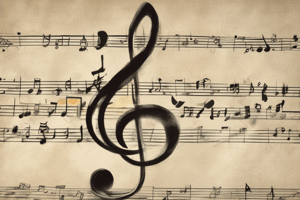Podcast
Questions and Answers
Which note value consists of half a beat?
Which note value consists of half a beat?
- Quarter note (♩)
- Whole note (♩)
- Eighth note (¼) (correct)
- Sixteenth note (➗₂)
What is the duration of a dotted quarter note?
What is the duration of a dotted quarter note?
- 3 beats (correct)
- 4 beats
- 2 beats
- 1 beat
In Western music, which letters represent the seven primary notes?
In Western music, which letters represent the seven primary notes?
- A, B, C, D, E, F, G, H
- C, D, E, F, G, A, B
- D, E, F, G, A, B, C
- A, B, C, D, E, F, G (correct)
How many beats does a whole note consist of?
How many beats does a whole note consist of?
Which note value is equivalent to one-quarter of a beat?
Which note value is equivalent to one-quarter of a beat?
Which term in music notation represents periods of silence?
Which term in music notation represents periods of silence?
How many beats does a half rest represent?
How many beats does a half rest represent?
Which rest value consists of four beats?
Which rest value consists of four beats?
In music notation, how many beats does a quarter rest represent?
In music notation, how many beats does a quarter rest represent?
What is the duration of an eighth rest in relation to a whole note?
What is the duration of an eighth rest in relation to a whole note?
Which rest has a dotted version that increases its duration by half?
Which rest has a dotted version that increases its duration by half?
If a musician sees a sixteenth rest, how many beats should be silent?
If a musician sees a sixteenth rest, how many beats should be silent?
Flashcards
Notes
Notes
The fundamental building blocks of music's visual language, representing pitch and duration.
Note Names
Note Names
The seven fundamental notes in Western music, represented by the letters A, B, C, D, E, F, and G.
Note Values
Note Values
The symbols used to represent a note's duration in music notation.
Whole Note
Whole Note
Signup and view all the flashcards
Half Note
Half Note
Signup and view all the flashcards
Quarter Note
Quarter Note
Signup and view all the flashcards
Eighth Note
Eighth Note
Signup and view all the flashcards
Sixteenth Note
Sixteenth Note
Signup and view all the flashcards
Rests
Rests
Signup and view all the flashcards
Whole Rest
Whole Rest
Signup and view all the flashcards
Half Rest
Half Rest
Signup and view all the flashcards
Quarter Rest
Quarter Rest
Signup and view all the flashcards
Study Notes
Music Notation Essentials: Notes, Values, and Rests
Music notation is a visual language that allows musicians to communicate and perform a vast array of melodies and rhythms. In this article, we'll dive into the fundamental aspects of music notation: note names, note values, and rest names, as well as their corresponding values.
Note Names
Music notation uses the letters A, B, C, D, E, F, and G to represent the seven primary notes in Western music. These notes are further divided into upper and lower cases (e.g., C, c) to indicate whether they are in the treble or bass clef. Each note has an associated pitch, and its position on the staff (lines and spaces) corresponds to its pitch.

Note Values
Notes in music notation are represented by various symbols to indicate their duration. The most commonly used note values are:
- Whole note (♩): consists of four beats
- Half note (♩): consists of two beats
- Quarter note (♩): consists of one beat
- Eighth note (¼): consists of half a beat
- Sixteenth note (➗₂): consists of one-quarter of a beat
In addition to these note values, music also uses dotted notes to increase their duration by half. For example, a dotted quarter note (➗₄) consists of three beats, while a dotted eighth note (➗₄➗₂) consists of three-quarters of a beat.
Rest Names
Similar to note values, rests represent periods of silence in a piece of music. The most commonly used rest values are aligned with the note values:
- Whole rest (♩): consists of four beats
- Half rest (♩): consists of two beats
- Quarter rest (♩)
- Eighth rest (➗₂)
- Sixteenth rest (➗₄➗₂)
Rests also use dotted versions to increase their duration by half, just like dotted notes.
Putting It All Together
By understanding note names, note and rest values, and their corresponding positions on the staff, musicians can communicate and perform a vast array of musical compositions. This system of notation has been refined over centuries to create a visual language that is both expressive and universal.
Further Reading
Want to dive deeper into music notation and learn more about its history and nuances? Here are a few resources that can help:
- Stanford Music Theory Tutorial: This comprehensive resource covers topics in music theory, including notation and its history.
- MusicNotation.com: A collection of articles and videos that offer insights into the world of music notation.
- Wikipedia: Music Notation: An encyclopedic resource that covers the history and evolution of music notation.
In your journey to master music notation, keep in mind that this is just a starting point. The more you study, practice, and perform music, the more confident you'll become in reading and writing music notation.
Studying That Suits You
Use AI to generate personalized quizzes and flashcards to suit your learning preferences.




